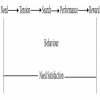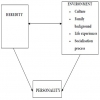Home | ARTS | Management Concepts & Organisational Behaviour
|
Individual Differences and Impact on Behaviour - Personality And Individual Differences
Management Concepts & Organisational Behaviour - Personality And Individual Differences
Individual Differences and Impact on Behaviour - Personality And Individual Differences
Posted On :
The range of personality traits is quite bewildering. Personality trait means the basic components of personality.
Individual
Differences and Impact on Behaviour
The range of personality traits is quite bewildering. Personality trait means the basic components of personality. The important personality traits that influence employee behaviour at work place are need patterns, locus of control, introversion and extroversion, self-esteem and self-concept, risk taking, self monitoring, Type A or Type B personality, and goal orientation. These are briefly explained below.
Primarily four personality needs can be identified that manifest themselves in the work setting. They are the needs for achievement, affiliation, autonomy, and dominance. Those with a high need to achieve engage themselves proactively in work behaviours in order to feel proud about their achievements and success. Those who are high in need for affiliation tend to work cooperatively with others. Those who are high in need for autonomy do well when not closely supervised. Those high in their need for dominance prove to be effective in situations where they can enforce their legitimate authority.
Locus of control refers to a generalized belief that events are either within one’s control (internal locus of control) or are determined by the fate or luck (external locus of control). People who have moderately strong internal locus of control are likely to perform better at work places. They are likely to be more successful than their external counterparts. Internals are more suitable for leadership positions and are likely to be
Personality traits are commonly understood in terms of introversion and extroversion. Introversion is the tendency in individuals which directs them to turn inward and experience and process feelings, thoughts and ideas within themselves. Extroversion refers to the tendency in individuals to turn outward searching for external stimuli with which they can interact. While there is some element of introversion as well as extraversion in all of us, based on dominance, people are regarded as either introverts or extroverts. Extroverts are sociable, lively, gregarious, and seek outward stimuli or external interactions. Introverts are quiet, reflective, introspective, and intellectual people. They interact with a few intimate people. Introverts perform well when they are alone and when the environment is quiet. Since managers have to constantly interact with individuals both within and outside the organization and be able to influence them to achieve organization’s goals, it is expected that extroverts prove to be better managers than introverts.
Personality differences can be seen in the willingness of people to take risk. Some managers are prepared to take risk and act on little information and quickly also. They prove to be as much effective as those other managers that are averse to take risk and make decision cautiously.
It refers to a person’s level of sensitivity and ability to adapt to situational cues. High self-monitors change their behaviour quite easily to suit the situation whereas low self monitors reveal their moods and personal characteristics to others who can easily predict their behaviour in a given situation. Self monitoring personality trait is important in carrying out organizational activities. Employees having this trait emerge as better performers, better leaders and are likely to grow faster in the organization.
Self esteem is the result of a person’s continuing self-evaluation. Self-esteem refers to the extent to which an individual consistently regards himself as capable, successful, important, and worthy. Self-esteem is an important personality factor that determines how managers perceive themselves and their role in the organization. It is important to self-concept, which refers to the way individuals define themselves as to who they are and derive their sense of identity. High self-esteem leads to a high sense of self-concept, which in turn, reinforces high self-esteem. The two are mutually reinforcing forces. As a trait, a person high in self-esteem is likely to take on more challenging assignments and be successful, thus enhancing their self-concept. That means they define themselves as highly valuable and valued individuals in the organization. The higher the self-concept and self-esteem of a person, the more he contributes to the goals of the organization.
Individuals can be grouped into two types of personalities – Type A and Type B. Type A persons feel a chronic sense of time urgency, are highly achievement oriented, exhibit a competitive drive, and are impatient when their work get slowed down for any reason. In contrast, Type B persons are easy going individuals who neither have sense of time urgency, nor the competitive drive. Type A individuals are more prone to heart attacks than Type B individuals. While helping the organization to move ahead in a relatively short period of time, Type A persons may suffer from health problems which are harmful to themselves apart from the organization.
An important personality difference affecting behaviour at work is goal orientation. There are two orientations – learning goal orientation and performance goal orientation. A person with learning orientation develops by acquiring new competencies whereas a person with performance orientation demonstrates competencies by seeking favorable judgments from others. As is well known, some individuals are highly work-oriented while others try to do the minimum that is necessary for not being fired on the job. The extremely work oriented person gets greatly involved in
In the above discussion, it is
evident that personality traits are important for employees, managers and
organizational effectiveness. With personality differences, we are able to understand,
how they affect the behaviour of the people in organizations.
The range of personality traits is quite bewildering. Personality trait means the basic components of personality. The important personality traits that influence employee behaviour at work place are need patterns, locus of control, introversion and extroversion, self-esteem and self-concept, risk taking, self monitoring, Type A or Type B personality, and goal orientation. These are briefly explained below.
Need Patterns
Primarily four personality needs can be identified that manifest themselves in the work setting. They are the needs for achievement, affiliation, autonomy, and dominance. Those with a high need to achieve engage themselves proactively in work behaviours in order to feel proud about their achievements and success. Those who are high in need for affiliation tend to work cooperatively with others. Those who are high in need for autonomy do well when not closely supervised. Those high in their need for dominance prove to be effective in situations where they can enforce their legitimate authority.
Locus of Control
Locus of control refers to a generalized belief that events are either within one’s control (internal locus of control) or are determined by the fate or luck (external locus of control). People who have moderately strong internal locus of control are likely to perform better at work places. They are likely to be more successful than their external counterparts. Internals are more suitable for leadership positions and are likely to be
Introversion and Extroversion
Personality traits are commonly understood in terms of introversion and extroversion. Introversion is the tendency in individuals which directs them to turn inward and experience and process feelings, thoughts and ideas within themselves. Extroversion refers to the tendency in individuals to turn outward searching for external stimuli with which they can interact. While there is some element of introversion as well as extraversion in all of us, based on dominance, people are regarded as either introverts or extroverts. Extroverts are sociable, lively, gregarious, and seek outward stimuli or external interactions. Introverts are quiet, reflective, introspective, and intellectual people. They interact with a few intimate people. Introverts perform well when they are alone and when the environment is quiet. Since managers have to constantly interact with individuals both within and outside the organization and be able to influence them to achieve organization’s goals, it is expected that extroverts prove to be better managers than introverts.
Risk - taking
Personality differences can be seen in the willingness of people to take risk. Some managers are prepared to take risk and act on little information and quickly also. They prove to be as much effective as those other managers that are averse to take risk and make decision cautiously.
Self – Monitoring
It refers to a person’s level of sensitivity and ability to adapt to situational cues. High self-monitors change their behaviour quite easily to suit the situation whereas low self monitors reveal their moods and personal characteristics to others who can easily predict their behaviour in a given situation. Self monitoring personality trait is important in carrying out organizational activities. Employees having this trait emerge as better performers, better leaders and are likely to grow faster in the organization.
Self – Esteem and Self-Concept
Self esteem is the result of a person’s continuing self-evaluation. Self-esteem refers to the extent to which an individual consistently regards himself as capable, successful, important, and worthy. Self-esteem is an important personality factor that determines how managers perceive themselves and their role in the organization. It is important to self-concept, which refers to the way individuals define themselves as to who they are and derive their sense of identity. High self-esteem leads to a high sense of self-concept, which in turn, reinforces high self-esteem. The two are mutually reinforcing forces. As a trait, a person high in self-esteem is likely to take on more challenging assignments and be successful, thus enhancing their self-concept. That means they define themselves as highly valuable and valued individuals in the organization. The higher the self-concept and self-esteem of a person, the more he contributes to the goals of the organization.
Type A and Type B Personalities
Individuals can be grouped into two types of personalities – Type A and Type B. Type A persons feel a chronic sense of time urgency, are highly achievement oriented, exhibit a competitive drive, and are impatient when their work get slowed down for any reason. In contrast, Type B persons are easy going individuals who neither have sense of time urgency, nor the competitive drive. Type A individuals are more prone to heart attacks than Type B individuals. While helping the organization to move ahead in a relatively short period of time, Type A persons may suffer from health problems which are harmful to themselves apart from the organization.
Goal - Orientation
An important personality difference affecting behaviour at work is goal orientation. There are two orientations – learning goal orientation and performance goal orientation. A person with learning orientation develops by acquiring new competencies whereas a person with performance orientation demonstrates competencies by seeking favorable judgments from others. As is well known, some individuals are highly work-oriented while others try to do the minimum that is necessary for not being fired on the job. The extremely work oriented person gets greatly involved in
Tags : Management Concepts & Organisational Behaviour - Personality And Individual Differences
Last 30 days 552 views














